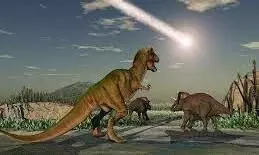
Asteroid that killed dinosaurs also halted crucial life process: study
text_fieldsApproximately 66 million years ago, the age of dinosaurs came to a dramatic end when a colossal asteroid struck a shallow sea near present-day Mexico, creating a city-sized crater. The exact sequence of events leading to the mass extinction of 75% of Earth's species following this cataclysmic impact has long been a mystery.
Earlier research had suggested that sulphur released during the impact, combined with soot from widespread wildfires, triggered a global winter, causing temperatures to plunge.
However, a new study, published in the journal Nature Geoscience on Monday, proposes that the primary culprit behind this mass extinction event may have been fine dust generated from the pulverised rock that was ejected high into Earth's atmosphere in the aftermath of the impact.
This fine dust played a significant role in blocking the sun's rays, preventing photosynthesis, a crucial biological process for sustaining life, for nearly two years after the catastrophic event.
Lead author and planetary scientist Cem Berk Senel, a postdoctoral researcher at the Royal Observatory of Belgium, explained, "Photosynthesis shutting down for almost two years after the impact caused severe challenges (for life). It collapsed the food web, creating a chain reaction of extinctions."
Scientists employed advanced technology to analyse the data. They developed a new computer model to simulate global climate following the asteroid impact. The model was based on historical climate information and new data obtained from sediment samples from the Tanis fossil site in North Dakota. These samples captured a 20-year period following the impact.
The study also examined data from samples of silicate dust particles that were propelled into the atmosphere in a plume before settling back on Earth's surface. These dust particles took approximately 15 years to finally descend. The researchers suggested that the global climate may have cooled by as much as 15 degrees Celsius during this period.























